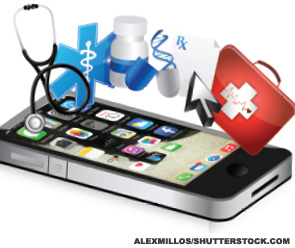
With gusto, Apple’s senior vice president of software engineering, Craig Federighi, unveiled HealthKit over the summer at the company’s Worldwide Developers Conference. It’s the computer giant’s fierce foray into the healthcare realm, with bold visions of patients and doctors being connected basically with the tap of a screen and speedy healthcare delivered without even the need to set foot in a clinic.
The number of healthcare apps on the iPhone is vast, but because the information gathered by those apps—miles walked, blood pressures, glucose levels, pain levels—aren’t in sync, the utility of them is greatly diminished, goes Apple’s thinking.
“Up to now, the information gathered by those applications lives in silos—you can’t get a single comprehensive picture of your health situation. But now you can—with HealthKit,” Federighi dramatically proclaimed on a San Francisco stage.
Mayo Clinic has collaborated with Apple, and that could mean a more intimate link between physician and patient than ever before, Federighi suggested. If a patient takes his blood pressure at home, he said, HealthKit would tell the Mayo health app, which could tell whether the reading was within the patient’s acceptable range.
“If not, it can contact the hospital proactively, notify a doctor, and that doctor can reach back to that patient, providing more timely care,” he said.
How could the app help with rheumatology? With patients with rheumatologic conditions requiring regular monitoring, the platform could potentially be a big boost, but how it plays out remains to be seen.
Even at Mayo, implementation hasn’t gotten down to the individual division level, a spokesman said.
Integrating Mayo Clinic Data
The newest development is the release of Mayo’s updated app, which—by way of HealthKit—works together with Apple’s “Health” app, allowing users to see their Mayo Clinic data from office exams alongside fitness and nutrition data stored in Health.
Paul Limburg, MD, a physician in the Division of Gastroenterology and Hepatology at Mayo and the medical director of Mayo Clinic Global Business Solutions, describes the collaboration with Apple as an obvious route in order to tap into Mayo’s expertise for the greatest effect.
Mayo sees 1.2 million patients a year across its campuses, but could improve care for far more people, Dr. Limburg says.
With patients with rheumatologic conditions requiring regular monitoring, the platform could potentially be a big boost, but how it plays out remains to be seen.
“Our ambitious goal is to reach out to hundreds of millions of people to try to address their health and wellness needs where they are, when we may be of most benefit,” he says. “Working with Apple to be able to scale that Mayo Clinic knowledge—which we would consider our core asset—is really a fantastic opportunity. It extends our ability to deliver high-quality affordable health information, health guidance and healthcare to everyone.”
He acknowledges that with such a close link to a new concept, risk is attached.
“As we move outside that traditional patient–physician relationship into a different kind of relationship with individuals or with people, there’s always some risk. … It’s not what we’ve been doing for 150 years. At the center, though, the primary value of Mayo Clinic is [that] the needs of the patient come first. This is an extension of being able to meet that need prior to somebody becoming a Mayo Clinic patient.”
He also stresses that it’s not expected that healthcare-by-smartphone will become the dominant force in healthcare tomorrow. Many patients with chronic conditions, and who might be in the most need of close monitoring, might have no interest in using a smartphone or HealthKit as a way to get their medical care.
“While this is an area where we think that there are a lot of opportunities for us to meet needs with our digital tools, our digital knowledge, it’s clearly not the only way that we’re reaching out,” Dr. Limburg says. “We’re trying to get knowledge out there to individuals on their terms, when they want it, how they want it, meeting their needs but also their learning preferences.”
He says it’s too early to have actually seen an example of a patient having entered data into an app at home and then getting a follow-up call from a doctor as a result.
Beyond Mayo
Other institutions are developing, or considering developing, projects making use of HealthKit.
Reuters has reported that a pilot project at Stanford University Medical Center sets out to track blood sugar in children with diabetes, and another at Duke University Hospital is tracking blood pressure and weight in patients with cancer and heart conditions.
Kaiser Permanente is considering its options and is excited about HealthKit’s prospects, spokesperson Amanda Wardell says.
“We’re exploring how we can leverage HealthKit to help our members track and integrate their health information in meaningful ways and strengthen the patient/physician relationship,” she says. “The introduction of Apple’s HealthKit and Health app seem to align with our belief that the key to helping people live healthier lives is giving them the tools and information they need to make healthy decisions.”
She says there are no new apps being developed yet, but Kaiser Permanente is “testing HealthKit to see how it might be integrated into our digital offerings.”
Use in Rheumatology
Paul Sufka, MD, a rheumatologist in Minnesota and a technology enthusiast who discusses technology in a regular podcast, says he thinks the quality of the information entered by the patient might pose a problem for the long-term success of HealthKit.
“I’m highly skeptical that HealthKit will change any sort of outcomes in most fields,” Dr. Sufka says. “I think that rheumatology is a field where data gathering is going to be a big limiting factor, since I’m not aware of any good way for a device to gather patient data in the background.”
Still, Dr. Sufka hopes HealthKit will extend its reach, which might lead to wider use of valuable apps that might not yet be meeting their potential. He says he helped design an app, called MyRA, which tracks location and intensity of joint pain over time, as well as other symptoms such as fatigue. He says it’s a quality app, but “I’m not sure how much traction the app has received. I do hope they plan to connect it to HealthKit.
Thomas R. Collins is a freelance medical writer based in Florida.
